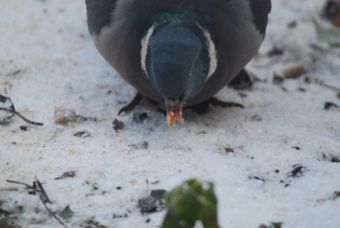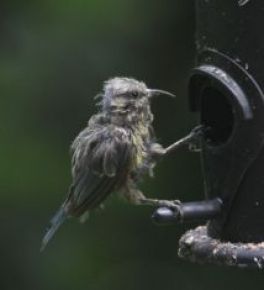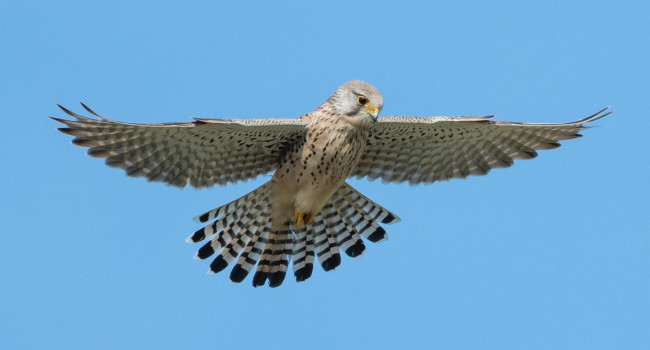Big Beak Extra!
The following, fascinating information supplements the ‘Big Beaks Go Global!’ article in Bird Table (Issue 65). If you are not a BTO Garden BirdWatcher and would like to receive this article for free, please contact the Garden Ecology team: gbw [at] bto.org or 01842-750050.
Tim Harrison (BTO) and Dr Colleen Handel (U.S. Geological Survey’s Alaska Science Center) outline the profound behavioural and health implications of deformed beaks both here and in Alaska.
Behaviour
Alaskan and UK birds show remarkably similar behaviours when dealing with their deformities. Most birds with long, twisted beaks simply turn their heads sideways so they can pick up morsels from bird feeders but it can take them much longer than normal to get their food. Carol and Joy Mitchell-Lisle, Cheshire, saw a Blackbird, Dunnock and Woodpigeon with bill deformities on their patch, the latter of which, with its crossed bill, tried more than 20 times to pick up a peanut in the snow before eventually being successful, and stayed feeding in the garden after dark. One bold Steller’s Jay with a crossed and overgrown beak would tap on the window of an Alaskan resident, Bev Dodge, who would then go out and hand-feed the jay shelled peanuts. Some chickadees will wait patiently in the snow below winter feeders for small pieces to be dropped by woodpeckers pounding on suet blocks above.
In Alaska, mid-winter nights are long and bitterly cold, and so birds must feed efficiently during the short daylight periods to get the energy they need to survive. Because of their handicaps, many affected birds are forced to spend more time in risky situations, more exposed to predators such as weasels, cats and hawks. Many Alaskans have reported the sudden disappearance of their distinctive feathered friends during this time, or have found their emaciated bodies huddled in a warm crevice near a feeder. Severely afflicted birds become more dependent on human-provided foods, and crows will resort to dumpster-diving in parking lots of hamburger stands when they can no longer pry open more nutritious mussels on the local Alaskan beach. In another interesting case, Sheila Hill, South Yorkshire, saw a Jackdaw with a beak deformity being fed by another, presumably its parent, during November – long after the breeding season had ended.
Deformed birds in Alaska have been found to be clever in their zeal to reproduce. Some chickadees were filmed in nest boxes as part of a study to see how beak deformities affected their breeding behaviour and success. Surprisingly, abnormal birds were able to attract mates and raise young. One male with an extraordinarily long, curved beak was amazingly adept at capturing masses of dragonflies and other insects to feed his young. When he tried to place the insects into the gaping mouths of his hungry chicks, however, he found it impossible to manoeuvre properly. His ‘normal’ mate’s creative solution was captured on film—she simply plucked insects out of his massive beak and fed the chicks herself.
The other fascinating behaviour concerns that of householders who host a bird with a deformed beak. A frequent sentiment of Big Garden Beak Watchers has been the affection that they feel, or have felt, for said individuals. Perhaps this is driven by a sense of a duty of care, or perhaps by admiration for their struggle in the face of adversity. Some Alaskans have also become exquisite caretakers of their more faithful visitors. Householders bake ‘Birdie Corn Bread’ filled with seeds, insects and berries, shave pieces of hormone-free suet and add vitamins to water dishes for their small patients. Some keep detailed histories of birds with distinctly recognizable deformities and assign nicknames such as ‘Hook’, ‘Longbeak’, ‘Curvin’’, ‘Edward’ (or, more formally, ‘Edward Scissorhands’) and, of course, ‘Beaky’ (or, in the case of one householder ‘Beaky I, II and III’). Somewhat predictably, there was also one report of ‘Invasion by the Mutant Tits’!
General health
Detailed observations made by householders are also helping us to understand the extent to which the birds’ general health might be compromised by beak deformities. In Alaska, dirty, matted feathers are a common sight among birds with grossly deformed beaks. A bird’s feathers serve as a custom-fitted down jacket, protecting its wearer from cold temperatures that can otherwise cause hypothermia and death. Birds that are unable to preen because of their unwieldy beaks lose that vital thermal protection. Abnormal skin conditions, including inflamed skin and missing patches of feathers, have also been found in about 15% of the birds with abnormal beaks examined in Alaska, and electron microscopy has revealed structural differences in feathers. Keratin is an integral component not only of beaks but of skin and feathers as well, suggesting that the beak deformities are likely signs of a more generalized keratin disorder.
Interestingly, however, while some birds have been reported with poor feather condition through Big Garden Beak Watch, more than three quarters of birds have had plumage that was considered, by survey participants, to be similar to that of a 'normal' individual of the same species. Moreover, only 6% of deformed birds appeared to be diseased (e.g. fluffed-up feathers, lethargic), and some individuals have proved to be popular additions to gardens for years.
Thanks – and keep watching!
The search for clusters of birds with beak deformities has now become global, and networks of dedicated observers such as those in the Big Garden Beak Watch, the Alaska Backyard Birders and Cornell’s FeederWatch Project will be vital to this effort. Consistent monitoring through time and space will allow us to track the spread of such abnormalities and identify potential causes. A diagnostic test of this disorder will provide the ultimate key as to whether or not these global clusters are truly linked. In the meantime, please keep careful watch!
Have you ever seen a bird with a beak deformity in your garden? Please let us know through Big Garden Beak Watch
Follow the latest Alaskan results









Share this page